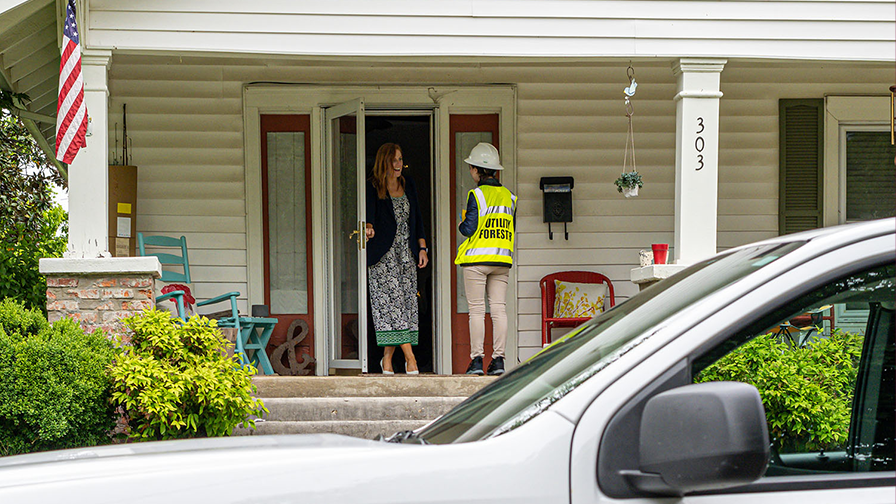- Vegetation Management Services
- Industries
- In Your Neighborhood
- About
- Careers
- Webinars
- Articles
Customer Communication: The Key to an Effective UVM Program

Customer Communication: The Key to an Effective UVM Program
By David Burke, director of operations, ACRT
Last year, I had an eye-opening experience as a homeowner – much like when a doctor becomes the patient. Twice, I found myself having to leave work to figure out why there were random, unmarked vehicles driving through my property. This was a concern because I didn’t have the opportunity to appropriately secure my animals. Despite having previously worked on that utility’s system and being familiar with the work being performed, additional communication could have gone a long way.
When you’ve been in the industry for more than two decades like me, it can be easy to take customer communication for granted and even more so, fail to pass along that basic customer service foundation to industry newcomers.
The opportunity to communicate should never be ignored. When I take off my industry hat and look at this from a property owner’s point of view, I realize that even though a mailer came 18 months ago, things can get lost, people move, and so on. When planning your work, account for the additional time required to communicate why you’re there and what you’re doing.
Be situationally aware. It’s hard to know what personal state an individual might be in at the time we arrive on their property. ACRT Senior Operations Manager Jerry Staton explains in a T&D World article, the foundation of situational awareness is to look, think, and act. By practicing situational awareness, you might be able to pick up on cues that the homeowner isn’t receptive to a visit that day.
Provide advanced communication. It’s easy to go onto our customers’ property, do the necessary work, then go on with our days, especially when they’re not home. Yes, we have right-of-ways (ROWs) and it’s easy to fall into the “I have a right” mindset, but we’re still moving into somebody’s comfort space. You might be disrupting that person’s day or be unaware of what’s on their property – for me, it’s my horses. A crew wouldn’t know what concerns I have around opening a gate and driving through the field where my horses reside. By stopping and asking before performing work, we can alleviate stress on property owners.
Take time to introduce yourself. In today’s world, you have every right to be cautious of unannounced visitors. When I had four people show up on my property, it wasn’t unreasonable for me to take a questioning stance. Take the time to introduce yourself, properly identify yourself, explain why you’re there, describe what you’re looking for, and set expectations — are you going to be there a minute or are you going to be there an hour?
At the foundational level, there are a few things every industry organization should be doing to ensure the public is aware of the work that is taking place. It can be challenging to find that communication “sweet spot”, but utilizing social media, going door-to-door to deliver door hangers, and implementing a text blast system are great ways to get our messaging in front of our customers.
Every opportunity to leave a good impression on a property owner is important. If not treated with respect, organizations can be left with a hostile environment for all future planners and work done on that property. Ensuring a homeowner has a positive experience can go a long way in maintaining positive relationships and a productive workflow.
One organization that comes to mind for having a successful customer communication model is United Cooperative Services, an organization that delivers electricity to 14 different counties in North Texas. In a T&D World article, United Cooperative Services VP of Media and Community Relations Mauri Montgomery explains how one of the biggest influences on service reliability is something customers might not be aware of or even think about daily.
Implementing a successful customer communication model goes beyond the transfer of information. Keeping the community informed can keep our teams safe, minimize hostile customer interactions, avoid unnecessary financial implications, use field time effectively, and so on.
Prioritizing safety goes back to being situationally aware. When entering a property unknowingly, angry property owners may be encountered which can result in the escalation of physical harm – whether it’s attacking or threatening with some sort of weapon. Dangerous animals could harm workers if the property owners aren’t notified and given the proper time to corral or restrain said animals. There is also the chance of not knowing something is dangerous on the property like a covered-up well, an old culvert, or an old septic tank system that you probably shouldn’t roll a truck over.
It’s important for our industry to put ourselves in our customers’ shoes and reference the Golden Rule. We should be communicating with our customers as we would like to be communicated to. As a customer, we would (and do) want to be in the loop.
ACRT is the largest independent utility consulting company in the U.S. and empowers utilities to proactively manage vegetation across their entire rights-of-way. We consistently stay on top of and share relevant industry content with our employees and customers around the country.
Recent Posts
- After a Career in the Military, Stan Villiers Found His Home at ACRT 24th Jul 2024
- Arthur Brothers: Growing Together in the Utility Vegetation Management Industry 23th Jul 2024
- Embracing a Forestry Career: Balancing Tradition and Innovation 02th Jul 2024
- Embracing Change: A Journey in the UVM Industry 02th Jul 2024
- Fostering a Culture of Safety: Building from Within 26th Jun 2024
Categories
The Leader In Vegetation Management
We are all about people, and we put safety first. Ready to work with our well-trained team?